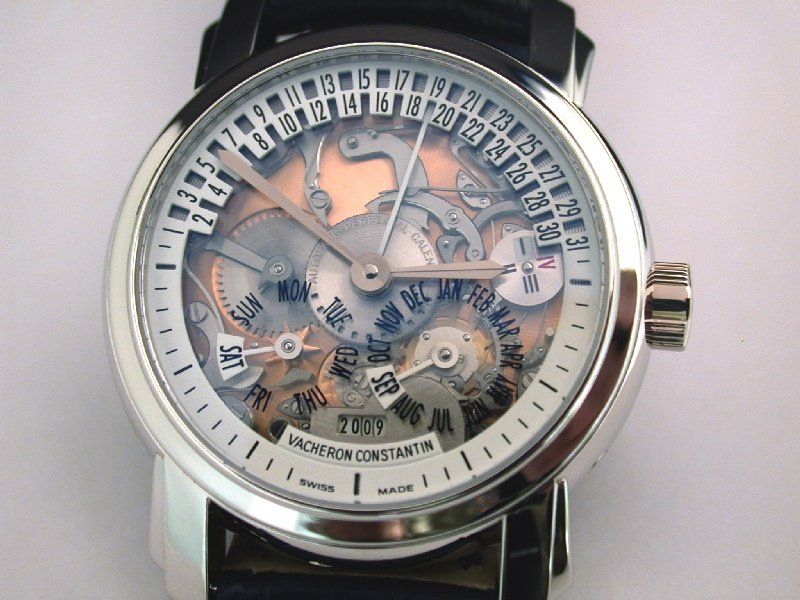
WHL
[VC Moderator]
4922

Malte Finds its Form
Malte Finds its Form
In the beginning
Vacheron Constantin launched its Malte line in 2000 with the a set of four mechanical watches with common DNA in their sharing of stepped lugs and sword-blade hands: Big date, Dual Time Regulator, Perpetual Chronograph, and Tourbillon.

Though examples of flared and stepped lugs as well as sword-blade hands exist the in the historical catalog, their use here was completely contemporary. Additionally, the case size was growing, in line with the trend for larger watches.
Subsequent years saw additions to the line. In 2002 the Malte Grande Classique joined the collection and featured the in-house manual-winding caliber 1400, a classically beautiful movement:

Photo from John Davis's review of the Malte Grande Classique
Then a perpetual calendar with retrograding date and four-digit year display (here pictured in its openworked design):

In 2004, a large manual winding chronograph joined the group (replacing in the catalog the much beloved Historiques Chronograph):

Photo by Amanico
A ladies watch with moonphase and power reserve, a dual time model, and a couple of skeleton watches would eventually join the ranks of Malte. The most recent round watch to join the Malte lineup is the Power Reserve-Date model:

A regal addition
Parallel to the Malte line was the Royal Eagle collection, originally launched in 2001, which shared the same case and hands as the Malte Tonneau Tourbillon. It was offered in white and yellow gold with the day and date subdials and COSC-Chronometer certification and in stainless steel with a large date and chronograph.

Vacheron Constantin would later rechristened the Royal Eagle as the Malte Tonneau in an effort to consolidate its product portfolio. Same watch, different name.
The Malte Tonneau Dual Time:

Making a new case
The second set of Excellence Platine watches in 2007 brought about a tourbillon with a regulator layout in an enlarged reinterpretation of the Malte case. The case was now 40 mm at its widest and 50 mm from lug to lug. There are two obvious consequences to this enlargement. First, there is more space to design the dial, something the designers are clearly taking advantage of in the watches released to date. Second, the bigger head was the need to shorten the lugs lest they protrude over the wrist, making the watch awkward to wear. The designers also toned down the prominence of the step in the lugs.
A non-EP version both in rose gold and platinum is in production with a dial that shows consistency with its Malte peers in terms of employing multiple finishes on the dial.

The older Malte Tonneau Chronograph has been phased out and now can only be found in the large size and in gold.

And just this year Vacheron Constantin added the Moonphase-Power Reserve to the collection.

A pillar of the community
Vacheron Constantin considers the Malte line, along with the cushion cased Quai de l’Ile and the round cased Patrimony, as one of the principle pillars of its product portfolio. These three pillars, along with the Overseas, obviously constitute the bulk of the brands annual production of 18,000 watches. I applaud Vacheron Constantin’s continuous refining of its product lines into better-defined segments (the others being Ladies Timepieces, Historiques, Métiers d’Art, and Cabinotier).
To date, all the watches in the Malte line have some type of complication, but complications are not intrinsic to its DNA, rather the case and dial treatments are. Being a pillar of the product offering I would eventually expect to see a simple version augment the collection. I haven’t been privy to any new releases from Vacheron Constantin, but I would be surprised if we don’t see the Day-Date-Power Reserve movement (caliber 2475), first seen in the Jubile 1755, at some point.
Both tonneau case styles will exist for the time being, but new additions will most certainly be in the new style.
The launch of the Malte collection a decade ago signified the start of a coherent product strategy for Vacheron Constantin. Though it has evolved significantly since then, one can still see the design codes installed at its beginning present in the watches designed today. I appreciate the development of more exciting dials in this collection, especially when compared with the more conservative Patrimony designs. I expect the Malte line to remain a significant pillar for the brand as it enters its second decade of production.
Bill

Malte Finds its Form

Bill, I am sorry to have just found this thread.

I'd like to see that too....
